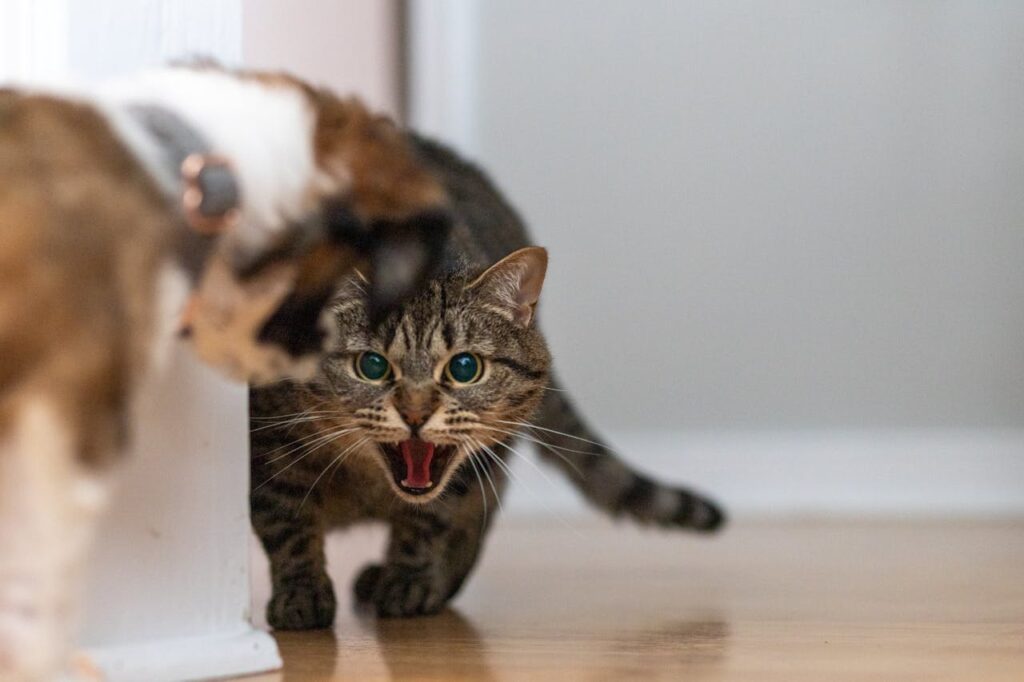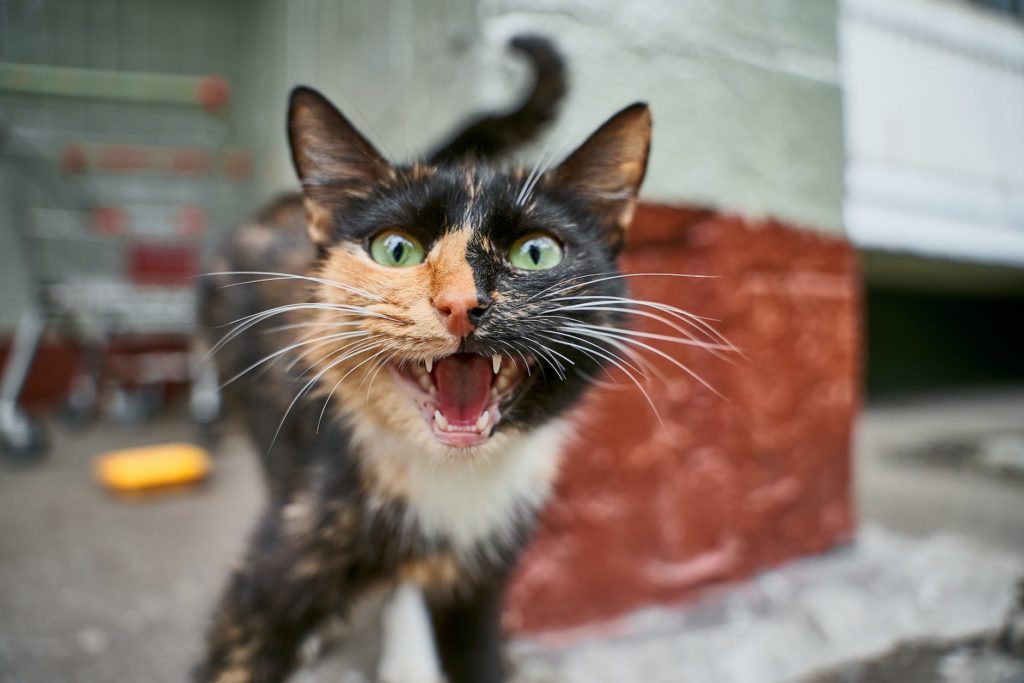Calm Non Recognition Aggression in Cats
Dealing with non-recognition aggression in cats can be a challenging experience for many pet owners. This type of aggression occurs when a cat becomes aggressive towards a companion cat, typically after a brief separation. It can be triggered by a change in the environment or the introduction of a new cat. In this article, we will explore how to deal with non-recognition aggression in cats, including ways to prevent it from occurring in the first place.
Live Pee Free! Odor Eliminator 100% Eliminates Pet Odor on Contact. 20% Off. No Enzymes, No Fragrance, No Detergent, No Bleach – Safe for Kids and Pets.Understanding Non Recognition Aggression
Cats are fascinating creatures, and their behavior can be as captivating as it is complex. One perplexing issue that many cat owners encounter is known as non-recognition aggression. This term describes a situation where a cat behaves aggressively towards another familiar cat, often due to stress, anxiety, or changes in the environment. Understanding this type of aggression is essential for any cat owner seeking harmony in their multi-cat household. In this post, we will explore ten empowering solutions to calm non-recognition aggression in cats, allowing both you and your furry friends to thrive.
Recognizing the signs of non-recognition aggression is the first step towards addressing it. Cats may hiss, growl, swat, or even pounce on other familiar cats in moments of sudden distress or confusion. The repercussions of aggression can affect not only the cats involved but also the household dynamics. Fortunately, there are effective strategies owners can implement to diffuse these situations and promote a peaceful environment.
Table of Contents
1. Create a Safe Space
Why a Safe Space Matters
Creating a safe space for your cats is essential when it comes to calming non-recognition aggression. This area should be a refuge where they can retreat, feel secure, and re-establish their boundaries. A safe space often consists of a cozy bed, some scratching posts, and toys that can engage their minds. Calm Non Recognition Aggression in Cats. Make sure this space is quiet and away from the hustle and bustle of daily activities. When cats feel safe, they are less likely to act out aggressively towards one another.
Implementing Safe Spaces Effectively
To implement this solution, observe your home and identify areas that can be transformed into safe spaces. Utilize shelves or high spots to provide vertical space, as many cats appreciate being up high. Calm Non Recognition Aggression in Cats. Cats need their surroundings to feel manageable, so consider adding barriers, like baby gates, to create a defined area. Rotating safe spaces can also help, allowing different rooms or areas to serve this purpose depending on the dynamics between the cats.
2. Use Feliway Diffusers
The Power of Pheromones
Feliway diffusers have gained popularity as a calming tool for various feline behavioral issues, including non-recognition aggression. They release synthetic pheromones that mimic the comforting scent produced by cats, promoting a sense of calm and security. Calm Non Recognition Aggression in Cats. Utilizing these diffusers can create a more peaceful environment for your cats, making them less prone to aggressive behaviors.
Strategic Placement of Feliway
To be effective, place Feliway diffusers in common areas where your cats typically interact. Provide a gentle, ongoing presence of the calming pheromones. Calm Non Recognition Aggression in Cats. Remember to replace the refills as recommended to maintain consistent effectiveness. If you’re introducing a new cat or moving homes, consider starting Feliway treatment a few days in advance to set a calming tone before the big changes begin.
3. Gradual Reintroduction
The Importance of Slow Interactions
When non-recognition aggression occurs, a gradual reintroduction often proves beneficial. This process involves slowly reintroducing the cats to each other’s presence, taking careful steps to avoid triggering aggression. Calm Non Recognition Aggression in Cats. Start by isolating the cats in separate areas of the house, allowing them to become accustomed to their individual spaces once again.
Step-by-Step Reintroduction Process
After a few days of separation, initiate brief interactions. Use a baby gate or crate to allow them to see each other without direct contact. Calm Non Recognition Aggression in Cats. Engage them with treats, toys, or other positive reinforcement tools. Gradually increase the duration of these interactions, monitoring their behavior closely. If aggression resurfaces, revert to shorter sessions and give them more time apart. Patience is key in this process, as every cat is different.
4. Maintain a Consistent Routine
How Routine Helps Your Cats
Cats thrive on routine and familiarity. Disruptions, whether through changes in the environment or daily schedule, can cause heightened stress and lead to non-recognition aggression. Calm Non Recognition Aggression in Cats. Maintaining a consistent routine helps your cats feel secure as they can predict when and where they receive food, attention, and playtime.
Practical Tips for Consistency
To create a consistent routine, establish regular feeding schedules, playtimes, and grooming sessions. Be aware of changes and try to maintain stability during transitions. Calm Non Recognition Aggression in Cats. For example, if you’re introducing a new pet or changing your home environment, ease them into these changes gradually. By providing predictability, you reduce the likelihood of anxiety-related aggression among your cats.
5. Encourage Playtime
The Role of Play in Cat Behavior
Play is a vital component of a cat’s life, contributing significantly to their overall well-being. Engaging in interactive play allows cats to expend energy and reduces stress levels. Calm Non Recognition Aggression in Cats. Providing regular playtime can foster positive reinforcement and decrease the chances of non-recognition aggression.
Selecting Appropriate Toys
Choose toys that encourage interaction and mimic hunting behaviors, such as feather wands, laser pointers, or even puzzle toys filled with treats. Play together regularly and encourage cooperative play sessions between cats to strengthen bonds between them. Calm Non Recognition Aggression in Cats. Alternating toys also ignites new interests and keeps their hunting instinct sharp, making playtime more enjoyable.
6. Environmental Enrichment
Why Enriching the Environment Matters
Cats are naturally curious creatures, and they thrive in stimulating environments. Creating an enriching space can reduce anxiety and deter aggressive behaviors. Calm Non Recognition Aggression in Cats. Environmental enrichment can take many forms, including providing vertical spaces, hiding spots, and engaging toys.
Ideas for Enrichment Activities
Include various types of scratching posts, climbing structures, and tunnels to give your cats numerous exploration options. Rotating toys can introduce new challenges and ensure that cats remain engaged. Calm Non Recognition Aggression in Cats. Additionally, consider incorporating puzzle feeders that require problem-solving skills and slow down their eating—both of which can divert attention from aggressive outbursts.
7. Observe Body Language
Understanding Your Cat’s Signals
Cats communicate using subtle body language cues, and understanding these signals is crucial for preventing non-recognition aggression. Familiarize yourself with your cats’ body language to anticipate potential conflicts early on. Calm Non Recognition Aggression in Cats. When you notice signs of stress, such as flattened ears, dilated pupils, or an arched back, intervene before situations escalate.
Techniques for Monitoring Interactions
Observing your cats during their interactions is essential. Look for changes in behavior that could indicate an impending conflict. If one cat seems uncomfortable, provide them with space or redirect their attention to another activity. Calm Non Recognition Aggression in Cats. By maintaining vigilant observation, you can prevent misunderstandings that lead to aggressive behavior.
8. Provide Separate Resources
The Importance of Territory
Resource guarding often contributes to non-recognition aggression among cats, especially in multi-cat households. Cats can be territorial, and when they’re forced to share, it can lead to increased stress and conflict. Calm Non Recognition Aggression in Cats. By ensuring each cat has access to its own resources, you provide a more peaceful coexistence.
Creating Resource Stations
Designate separate food and water stations, litter boxes, and sleeping areas to minimize competition. A good rule of thumb is to have one more litter box than the number of cats in the house. This approach reduces stress around resources, allowing each cat to feel secure in their territory. Calm Non Recognition Aggression in Cats. Regularly clean the resources and ensure they are in good condition to promote their allure.
9. Consult a Veterinarian
When to Seek Professional Help
If traditional methods fail to calm non-recognition aggression in your cats, consider consulting a veterinarian. Aggression could reflect underlying health issues, such as pain or hormonal imbalances. Calm Non Recognition Aggression in Cats. A veterinary assessment can rule out these factors and help you determine how to assist your cats effectively.
Exploring Behavioral Modification Options
Veterinarians may recommend behavioral modification strategies or refer you to certified animal behaviorists for a more comprehensive assessment. In some cases, medication may be prescribed to alleviate anxiety or aggression. Calm Non Recognition Aggression in Cats. Collaborating with a professional ensures you’re taking the best approach for your cats’ needs and overall well-being.
10. Be Patient and Compassionate
Cultivating a Loving Environment
Above all, understand that addressing non-recognition aggression takes time and effort. Consistently approach your cats with patience and compassion as they navigate these challenging behaviors. Calm Non Recognition Aggression in Cats. Each cat has its personality, and it’s important to adapt your strategies to suit their specific needs.
Celebrate Small Victories
As you implement these solutions, celebrate small victories along the way. Progress may be slow, and you might encounter setbacks, but remaining positive will create an encouraging atmosphere for both you and your cats. Calm Non Recognition Aggression in Cats. With time and dedication, you will pave the way towards a harmonious household.
Embracing Tranquility
In conclusion, calming non-recognition aggression in cats requires a multifaceted approach, combining environmental adjustments and behavioral strategies. By creating safe spaces, using pheromone diffusers, and maintaining consistency, you can foster a peaceful environment in your home. Calm Non Recognition Aggression in Cats. Each cat’s nature is unique, so be observant and responsive to their needs. With patience, understanding, and love, you can significantly reduce aggressive behaviors and strengthen the bonds between your feline companions.

Understanding Non-Recognition Aggression
Non-recognition aggression is a prevalent issue among cats that can manifest when a cat has been separated from its companion for an extended period. Upon reuniting, the returning cat may fail to recognize its buddy, resulting in a hostile reaction. Calm Non Recognition Aggression in Cats. This aggressive behavior can lead to confrontations, causing injuries not only to the antagonistic cat but also to the companion.
It’s crucial to grasp that this aggression is not triggered by a lack of love or affection. Rather, it stems from a natural instinctive response to the unfamiliar scent and changes in the returning cat’s appearance, which can occur due to various factors during separation, such as alterations in the environment or smells from other locations.
Cats rely heavily on scent as a means of identification and communication. When they are apart, they may pick up various odors that can mask their familiar scent. Calm Non Recognition Aggression in Cats. Consequently, the cat that has remained at home may perceive the returning cat as an intruder, leading to defensive and aggressive behaviors. Signs of non-recognition aggression can include hissing, growling, swatting, or chasing.
To mitigate these aggressive tendencies, proper reintroduction techniques should be employed. Gradually reintroducing the cats in a controlled manner, utilizing pheromone diffusers, and allowing them to readapt to each other’s scents slowly can be beneficial. Calm Non Recognition Aggression in Cats. Creating a safe space where each cat can retreat if they feel threatened also contributes to easing tensions. Understanding this form of aggression is vital for maintaining harmony in a multi-cat household. With patience and a gentle approach, the bond between separated cats can be restored, promoting a peaceful and loving environment once again. This ensures that the affection shared is not overshadowed by misunderstandings triggered by scent recognition.
Preventing Non-Recognition Aggression
Preventing non-recognition aggression in cats requires careful planning and consideration. This type of aggression often arises when cats have been separated for an extended period, leading them to forget each other’s scent and social cues. Calm Non Recognition Aggression in Cats. Therefore, the best way to prevent this behavior is to ensure that the cats are not isolated from one another for long durations. If circumstances necessitate a separation—such as during a move or a home renovation—taking steps to prepare for their reunion is crucial.
When it’s time to reintroduce your cats, begin by keeping them in separate rooms. This allows them to adjust to the presence of one another without direct confrontation. Calm Non Recognition Aggression in Cats. Start by allowing them to sniff each other’s bedding or toys to reintegrate familiarity. Gradually, you can permit them to spend supervised time together. Initially, this can be done through a cracked door or a baby gate, where they can see and smell each other without the stress of direct interaction. Over time, as they become more comfortable and relaxed, gradually increase their shared time together.
In addition to systematic reintroduction, employing a pheromone spray or diffuser can play a significant role in easing tensions between cats. These products release synthetic pheromones that mimic the cat’s natural scents, which can evoke a sense of calm and security. Using them in the areas where the cats will meet can help reduce anxiety and potential aggression.
It’s also beneficial to create an engaging environment with plenty of distractions, such as toys, climbing structures, and perches. This helps redirect any nervous energy and promotes positive interactions. Calm Non Recognition Aggression in Cats. Remember, patience is key in this process, as each cat has its unique temperament and timeline for adjustment. With a thoughtful approach, you can foster a harmonious relationship between your feline companions.
Dealing with Non-Recognition Aggression
Non-recognition aggression in cats, while troubling, can be managed effectively with a thoughtful approach. If your cats are displaying this type of aggression, the first and most crucial step is to separate them and confine them to different rooms. This separation period allows each cat to calm down, alleviating the heightened anxiety that often accompanies these aggressive encounters. By providing a safe and quiet space, you help create an environment that minimizes stress and allows for emotional recovery.
It is equally vital to avoid punishing your cats for their aggressive behavior. Punishment can lead to further stress and anxiety, often exacerbating the underlying issues. Calm Non Recognition Aggression in Cats. Instead, it is beneficial to focus on redirection and reinforcement of positive behaviors. For example, if the cats are able to share space without aggressive interactions, offering treats or praise reinforces this desirable behavior. Creating a positive feedback loop can help them associate each other with pleasant experiences rather than fear or confrontation.
Positive reinforcement training can be a powerful tool in managing non-recognition aggression. Engage in interactive play sessions with your cats, using toys that encourage cooperation rather than competition. For instance, wand toys or laser pointers can create opportunities for simultaneous play, reinforcing their bond and teaching them that being together can be fun. Additionally, providing treat puzzles or feeding them in close proximity (but still separately) can promote peaceful coexistence and help them develop a sense of security around one another.
If aggression persists despite your efforts, or if you notice signs of extreme anxiety or distress in either cat, it may be prudent to seek the assistance of a professional animal behaviorist. These experts are equipped with the knowledge and tools to assess the situation more thoroughly. Calm Non Recognition Aggression in Cats. They may conduct behavior assessments and develop a tailored training plan specific to your cats’ needs. In some cases, they may also suggest medication to help manage anxiety levels, giving your cats a better chance at achieving calmness and reducing aggressive tendencies.

Ultimately, patience is key in addressing non-recognition aggression. This process may take time, and every cat is different, with its own unique personality and behavioral triggers. Consistent, positive reinforcement strategies, along with professional guidance when necessary, can help your feline friends navigate their relationship more amicably, allowing them to live together harmoniously in your home.
Conclusion
Dealing with non-recognition aggression in cats can be a challenging experience for pet owners. However, with careful planning and consideration, it is possible to prevent this type of aggression from occurring. If your cats do exhibit non-recognition aggression, it is important to take steps to address the problem, including positive reinforcement training and seeking the advice of a professional animal behaviorist if necessary.




